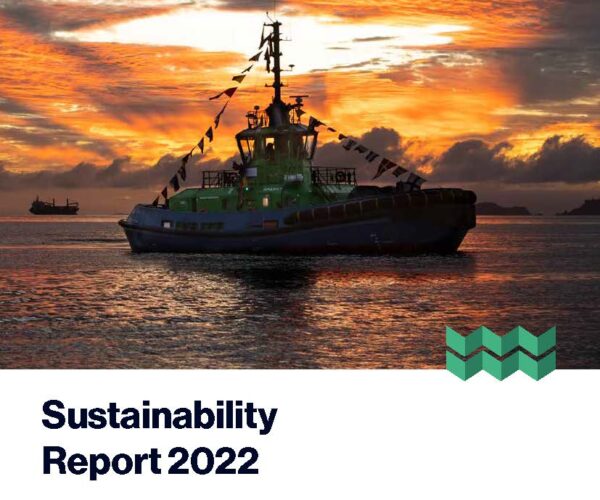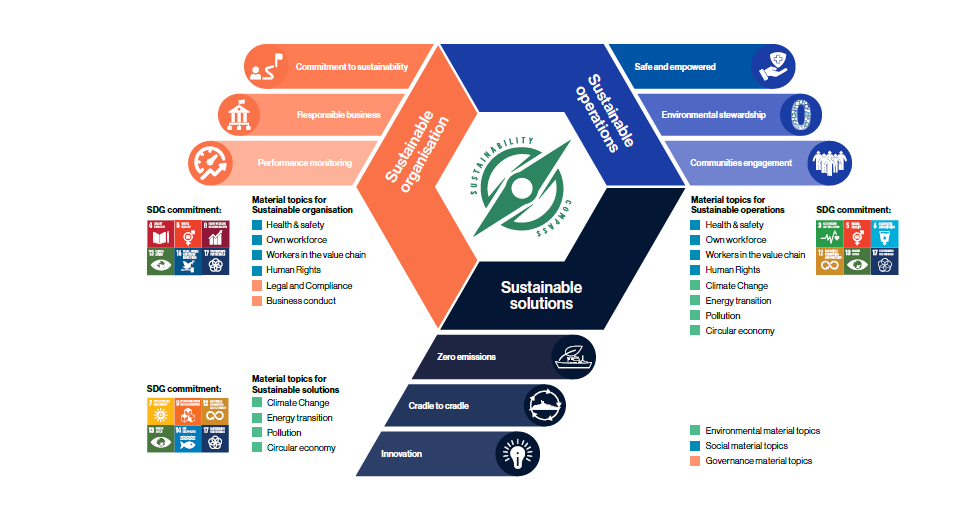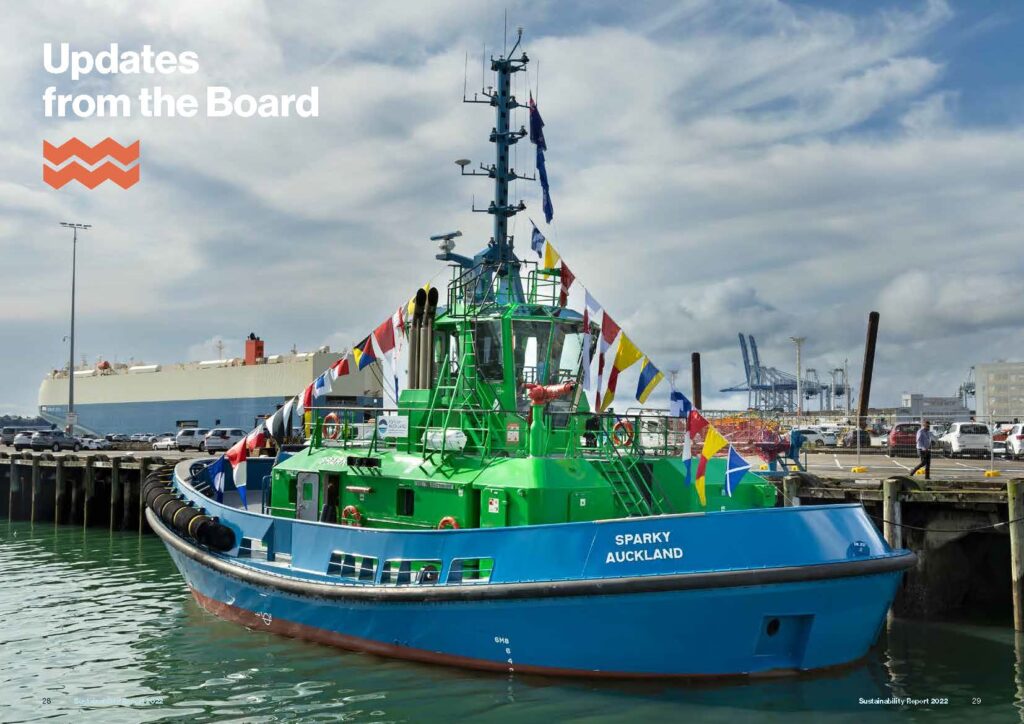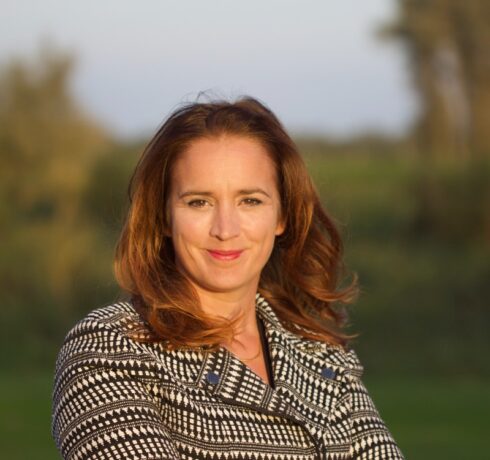Damen Shipyards Group CEO Arnout Damen’s announcement of the company’s ambition to become the most sustainable maritime solution provider in the world was a pivotal moment for the global shipbuilding industry. Damen would, once again, be leading the way. However, looking at the broad scope of the United Nations Sustainable Development Goals (SDGs), setting this target means so much more than just building so-called ‘green’ ships. Here to outline Damen’s sustainability goals is Damen Sustainability Manager Laure Jacquier.
 The Corporate Social Responsibility report.
The Corporate Social Responsibility report.
What does sustainability mean to Damen?
“It is all about the balance between the economics and the impact that the company has on society and environment. This is why people talk about the triple bottom line of ‘planet, people and profit’ – you cannot be sustainable if you only think about your profit, but you cannot be sustainable if you only think about the environment. And it is important to be realistic; I think it’s better to accomplish incremental, yet realistic, changes where people think differently and act differently rather than just saying ‘we are going to be net zero in a few years’. For Damen, sustainability is a journey.”
Does Damen have a target to be net zero?
“We are saying that we want to be net zero in 2050, which in fact is the same as the European targets. The difference is that we are saying that we want to achieve this in all our operations worldwide: not just Europe. This is very ambitious, but this is another aspect of the philosophy behind sustainability: that nobody is left behind. We want to take the whole Damen Shipyards Group and our supply chain on that journey.”
How much of a challenge is this going to be?
“It is going to be a challenge everywhere; we shouldn’t expect that it is going to be easier in Europe. Not only has almost every country around the world committed itself to the United Nations Sustainable Development Goals, but also we have huge operations in Europe. Look at Romania, for example, we will have to do more than just transferring to green electricity; we will have to think about significantly reducing our electricity consumption. This will require really big investments.”
 The Sustainability Compass highlights the most important sustainability goals of the Damen Shipyards Group.
The Sustainability Compass highlights the most important sustainability goals of the Damen Shipyards Group.
How is the ambition to ‘become the world’s most sustainable maritime solution provider’ structured in an organisation as big as Damen?
“We have taken a lot of steps forward in the past few years on the framework and organisation around the subject of sustainability – but also in our shipyards, products and employees. Each division in the Group provides three Sustainability Leads, these are people whose function is to translate Damen’s sustainability strategy and ambition within the division.”
How do you deal with the fact that the Damen Shipyards Group has such a broad product portfolio? For example, frigates are totally different to tugs.
“The global challenge of Damen Naval is very different from Damen Workboats. They don’t have the same type of customer so their priorities are different. But although they have completely different strategies on sustainability, we can still create cohesion within the various Damen divisions by bringing the Sustainability Leads together to exchange what they are doing. In this way, what they are learning in Damen Naval can be applied to the other divisions in Damen.”
“I think the biggest challenge for all Damen entities is to have a value proposition for the customer that can help sell our sustainable solutions." Laure Jacquier
Can you give an example of what other Damen divisions could learn from Damen Naval?
“An important area that Damen Naval can focus on is innovation; noise, for example. Reducing noise is important in a naval vessel but also has an impact on the people on the vessel, and life underwater too. This is something that customers find very important.”
And how do you deal with the fact that the UN’s 17 SDGs are so wide-ranging?
“That fact that we have such strong support from the CEO means that we are taking on some really difficult topics – things that we wouldn’t have been able to address within Damen a few years ago. For example, diversity and inclusion, now it is getting more normal to talk about this. I’m not talking about gender equality; I’m talking about real diversity. It is really beautiful to work on these topics; this is the magic of Damen.”
A big part of your job is to improve ‘employee engagement’. How is that progressing?
“In order to reach as broad an audience as possible we are working with our Sustainability Ambassadors to identify our communication needs and to help spread the word. There are more than 100 of these within the whole organisation – also in the Damen companies in Vlissingen.”
 Damen built Sparky, an award-winning all-electric RSD-E tug for the Port of Auckland in New Zealand.
Damen built Sparky, an award-winning all-electric RSD-E tug for the Port of Auckland in New Zealand.
What are the biggest sustainability issues in Vlissingen?
“I think the biggest challenge for all Damen entities is to have a value proposition for the customer that can help sell our sustainable solutions. Because our vessels will be 30 to 50 years in operation, this is the biggest impact that we have. So, we have to understand how to help our customer achieve their sustainability agenda; we have to understand what our customers are looking for. Although Damen Naval cannot come up with a ‘zero-emissions’ vessel, I think the biggest win that they can have, is to think about the circularity of their vessels.”
And even though the Damen companies in Vlissingen are all different, they all have the common theme of ‘supply chain’. What are your thoughts on this?
“Sustainability is more than making sure that your own operations are under control; all companies have to make sure that their supply chains are transparent and sustainable. This includes human rights and modern slavery aspects too. In fact, the European Union has two directives that are being published at the moment that focus on the responsibility of international companies in the supply chain. This is really important.”
You started off by saying that, for Damen, sustainability is a journey. Can we go back to that concept to conclude our conversation?
“Sustainability is indeed a journey, but it is a journey on foot. Sometimes it is possible to take a big leap like we did with Sparky [Damen’s award-winning all-electric RSD-E Tug] or with the icebreaker Nuyina, but most of the time it is about taking small steps. Besides looking at the amount of water used, the amount of waste produced, and reducing the amount of electricity used, it is also about creating a culture where everybody feels welcome and can come to work with a big smile. We cannot do everything at once, and we can be proud of the small things we are doing. What is important is that we are moving in the right direction.”
Want to read more about Damen’s achievements and ambitions regarding sustainability? You can download the Corporate Social Responsibility Report here.
Do you want to find out how to become a Damen Sustainability Ambassador? Then you can email sustainability@damen.com for more information.
>> Since conducting the interview for this article, Laure has left Damen Shipyards Group. We will keep you updated about her successor.

